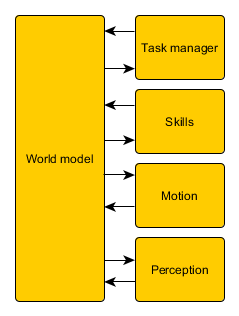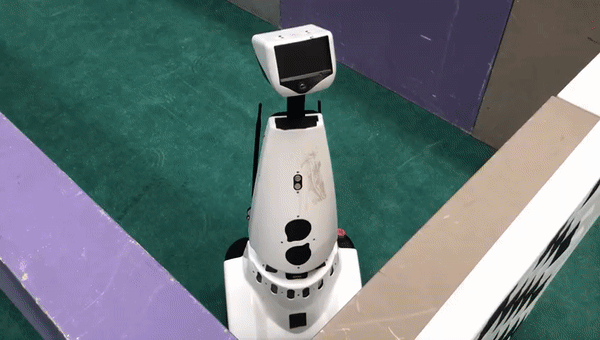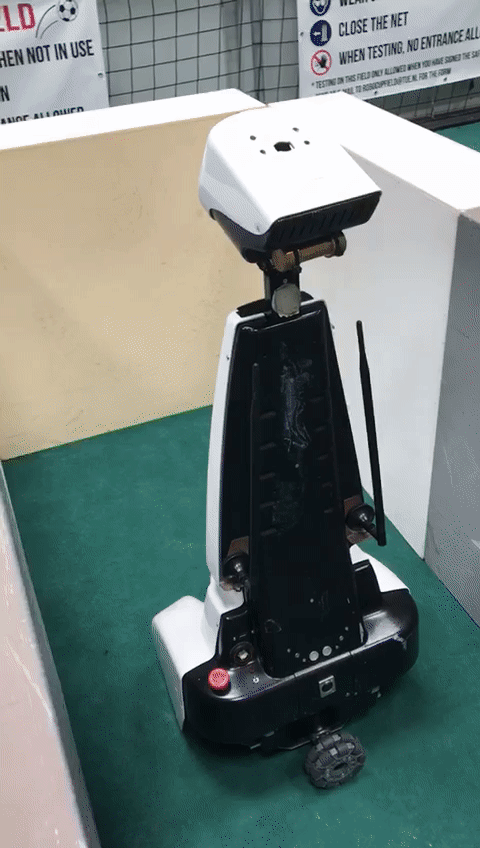Embedded Motion Control 2018 Group 3: Difference between revisions
| Line 162: | Line 162: | ||
This is done by letting PICO drive forward to the starting position and stopping in front of the wall. Then PICO will turn around such that he can drive backwards to the wall. Since PICO cannnot scan what is behind him, a diffrent method is used to see/feel the wall he should touch. This is done using the control effort. If the control effort becomes large enough, PICO will stop since this increase in control effort is caused by touching the wall. All in all, a short video will summarize the result far better, so let's watch the parking skills of PICO: | This is done by letting PICO drive forward to the starting position and stopping in front of the wall. Then PICO will turn around such that he can drive backwards to the wall. Since PICO cannnot scan what is behind him, a diffrent method is used to see/feel the wall he should touch. This is done using the control effort. If the control effort becomes large enough, PICO will stop since this increase in control effort is caused by touching the wall. All in all, a short video will summarize the result far better, so let's watch the parking skills of PICO: | ||
[[File:BackwardParking.gif|thumb|center| | [[File:BackwardParking.gif|thumb|center|300px|Backward parking.]] | ||
Note that this is a GIF, so you can't hear PICO say "I am parked!". | Note that this is a GIF, so you can't hear PICO say "I am parked!". | ||
Revision as of 14:11, 27 May 2018
Group Members
| TU/e Number | Name | |
|---|---|---|
| 0848904 | Luc (L.L.M.) van den Aker | l.l.m.v.d.aker at student.tue.nl |
| 0852908 | Thomas (T.) Neilen | t.neilen at student.tue.nl |
| 0909434 | Jeroen (J.W.) van de Valk | j.w.v.d.valk at student.tue.nl |
| 0896947 | Nourdin (N.) Kaai | n.kaai at student.tue.nl |
| 0883056 | Peter (P.) van Dooren | p.v.dooren at student.tue.nl |
| 0861750 | Ties (T.J.) van Loon | t.j.v.loon at student.tue.nl |
Initial Design
First off, the initial design itself is explained. After that, the report and presentation of it are shared.
Initial Design
Requirements
- PICO should make no collisions with any walls
- PICO cannot stand still for 30 seconds or longer
- For the escape room challenge, the robot should leave the room within 5 minutes
- For the hospital challenge, within 5 minutes, mapping, reverse parking and obtaining the object should be done
- Its surroundings should be made visible in a map
- PICO should be able to reach every position in the room
- PICO should be able to leave every room
- PICO should make distinction between the hall and rooms
- It should run autonomously, so in each challenge there should be no additional input
- To start your software, only one executable has to be called
- PICO should be able to recognize an object and stand still close to it
Functions
- PICO should be able to drive in any direction
- PICO should be able to turn around
- It should be able to detect walls
- PICO has to know its own position within the mapped map
- PICO is able to construct a map
- It should be possible to create a trajectory to a room
- PICO should be able to recognize an object
Components
- Sensors:
- Laser Range Finder (LRF)
- Wheel encoders (odometry)
- Actuator:
- Holonomic base (omni-wheels)
- Computer:
- Intel i7
- Ubuntu 16.04
Specifications
- Translation maximum: 0.5 m/s
- Rotation maximum: 1.2 rad/s
- Range of Laser Range Finder is assumed to be bigger than maximum room dimension
- The field of view of the Laser Range Finder is from -2 rad to 2 rad, divided in pieces of 0.004004
- The Laser Range Finder can only measure at one height
Interfaces
The interfaces of the initial design are shown here:

As shown in Figure 1, a world model is the link between all other parts. The tasks represent the highest level, meaning the most global work PICO has to do. The skills are needed to complete these tasks and some motions together form a skill. The perception contains the sensors, the continuous data. Below an overview of the different parts are given:
World model:
- Compose map
- Object recognition
Tasks:
- Mapping of the environment
- Backward parking at the specified location
- Searching for the object
Skills:
- Planning a trajectory
- Collision avoidance
- Backward parking
- Navigate
- Positioning in front of an opening
- Compose maps
Motion:
- Translation
- Rotation
Perception:
- Odometry
- Laser Range Finder
- Control effort
Report of Initial Design
Due to a misunderstanding, the report was not uploaded as a PDF yet. However, the full report was uploaded on this Wiki page (see below) before May 11th (17.00h), and now it is also uploaded as a PDF file (<1Mb). Our apologies for any inconvenience. The PDF of the report of the initial design can be found here: File:InitialDesign Group3.pdf
Presentation of Initial Design
On May 16th, all groups presnted their initial design. So we also presented our initial design and included two GIFs of our process so far. A PDF of the slides can be found here: File:InitialDesignppt.pdf
Escape Room Challenge
Since our code to map a room was not finished completely, a new code for the Escape Room Challenge was made. This code was kept simple and effective. PICO should drive to a wall, turn about 90 degrees to the left when it detects a wall within 0.4 meters from itself, adn follow the wall (without hitting it of course). Then it will scan for a hallway to exit the room. When he sees a way to exit the room, PICO will go through the opening in the wall.
Our first attempt during the Escape Room Challange was very successful! PICO drove out of the room, but we were convinced he could do it even faster. So we set the speed higher for the second try, and it was even faster. PICO drove out of the room within 29 seconds. This resulted in a second place and being one of the two teams that made it out of the room.
Here a shot video is shown of PICO leaving a room. Note that this is not filmed during the 'official' Escape Room Challenge. Due to our enthousiasm, we forgot to film, so we reconstructed the room during one of our test sessions.

Hospital Challange
To succeed in this challenge, we have divided the the 'problem' into three parts. These are the three part:
- Mapping
- Trajectory planning
- Motion control
Mapping
This part focusses on mapping each room and the hallway, and making one big map out of these.
Trajectory Planning
This part plans the trajactory PICO should take during the Hospital Challange.
Motion Control
This part makes sure that PICO moves as he should and follows the planned trajectory.
Backward Parking
When the map building is complete, PICO has to park backwards to the wall behind the starting position. Parking is done upon touching the wall. After PICO parked, PICO should say: "I am parked!".
This is done by letting PICO drive forward to the starting position and stopping in front of the wall. Then PICO will turn around such that he can drive backwards to the wall. Since PICO cannnot scan what is behind him, a diffrent method is used to see/feel the wall he should touch. This is done using the control effort. If the control effort becomes large enough, PICO will stop since this increase in control effort is caused by touching the wall. All in all, a short video will summarize the result far better, so let's watch the parking skills of PICO:

Note that this is a GIF, so you can't hear PICO say "I am parked!".